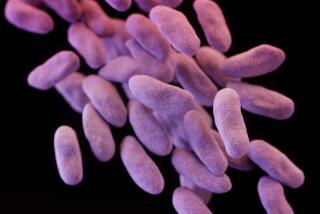Designer antibodies, nanoparticles, bacteria
- Share via
When you pop a pill in the future, don’t expect old-fashioned results. Thanks to new advances in the lab and a deeper understanding of the human body, drugs are becoming highly personalized and precisely targeted.
And the hope is they’ll also be more effective.
A new appreciation of our individual differences could spell the end of one-size-fits-all medicine. Our genes, lifestyles, environmental influences and even the bacteria in our guts work together to make us the people we are.
All of these factors — and more — dictate how we respond to pills, tablets and capsules. Clearly, we can’t expect a drug to work in the same way in each person.
Here’s a look at what’s on the horizon:
Antibodies get fancy: Many treatments of the near future will harness the power of antibodies — proteins that recognize invaders and flag them for the immune system to destroy. Our bodies naturally make antibodies against bacteria and viruses, but these days scientists are creating designer antibodies to find and block malfunctioning immune cells or interfere with proteins that are causing trouble.
The first antibody drug, Muromonab-CD3, was approved by the Food and Drug Administration in 1986 to prevent organ transplant rejection, which can happen when the T cells in a patient’s immune system recognize a new organ as foreign and try to attack it. Now dozens of therapies are on the market to treat various cancers, autoimmune diseases, asthma and arthritis. Hundreds more are in clinical trials with an array of targets, including compounds involved in chronic pain.
In the immediate future, patients can hope to benefit from a new generation of antibodies that carry molecules of chemotherapy drugs, says Mark Davis, a professor of chemical engineering at Caltech in Pasadena. When the antibodies seek out a particular trouble spot in the body, they’ll take the medication payload along for the ride.
This is how a chemotherapy treatment called Adcetris attacks two types of lymphomas. It’s the first antibody-drug hybrid on the market, and dozens more are in development or in human clinical trials.
Small wonders: It’s a cliche to say that size matters. But when designing drugs for the future, researchers are well aware that good things come in small packages. There’s growing excitement for a new approach to making drugs that uses ingredients ranging in size from 1 to 100 nanometers. That’s about the size of small viruses or most proteins — which means they can easily fit into many different cells.
Most of the current nanoparticle drugs are liposomes, tiny fatty spheres that simply collect in certain parts of the body and release drugs into the bloodstream. But there will be many new applications as nanoparticle drugs become more sophisticated..
“They’re just so much more multifunctional,” Davis says of the drugs currently in clinical trials. “They can do so many different things.”
Davis, for one, is trying to turn certain nanoparticles into “smart bombs” to fight cancer. He’s exploiting the fact that cancer cells are “leaky,” with larger-than-normal holes in their walls. This means particles of just the right size could enter the cells while leaving normal cells alone. One of Davis’ drugs is now in phase II clinical trials, being tested for four different cancers.
So far, the nanoparticles seem generally safer than the old-style drugs, but there isn’t enough data yet to know if they’re also more effective, according to Davis. “The hope is within this decade a number of them could get approved,” he says.
Other targeted nanoparticle drugs in earlier-stage clinical trials include tiny compounds made of various polymers, viruses, gold and gold-coated silica. Beyond fighting cancer, they could treat plaques in arteries, target invading viruses or stabilize blood flow to the brain after an injury. They’re being developed for medical imaging to produce crisp, high-contrast images of tiny numbers of tumor cells. They could even be useful as vaccines because they can ferry antigens to places in the body where they’ll be most effective at stimulating a response, like lymph nodes.
The ecosystem inside: Drug designers of the future will look beyond human cells to address something even more ubiquitous — the incredible number of bacteria we carry around in every nook and cranny of our bodies, from our intestines to our toenails. Research suggests this ecosystem may be involved in a surprising range of conditions, including asthma, cancer, obesity and autism.
Our bacterial partners have a big influence on how our bodies process drugs. For example, the drug levodopa helps treat Parkinson’s disease by converting into dopamine once it reaches the brain. But certain gut bacteria can break it down before it gets there, effectively neutralizing it.
In the future, drug treatments for a wide range of maladies could be tailored to patients based on their particular microbiome, says Peter Turnbaugh, a systems biology researcher at Harvard University in Cambridge, Mass. Personalized bacterial profiles could help doctors predict how drugs will work, making it that much easier to find the right treatment for the right person.






